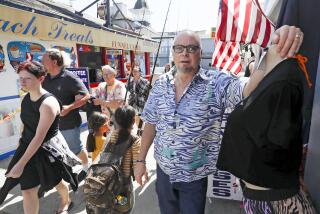Where Tarot Isn’t in the Cards
- Share via
NEW ORLEANS — Suddenly, the heart of the French Quarter looks a lot more like it did 30 years ago, and not everyone is happy about it.
As of this weekend, the incense-burning tarot card readers have been evicted from much of Jackson Square’s flagstone promenades.
The fortunetellers were frequented by tourists but accused by many locals of overrunning one of the most scenic and historic public spaces in urban America.
Their removal stems from the City Council’s latest effort to placate the artists who have painted in the square for more than half a century. The artists’ colony had been thinning out in recent years and members warned it would disappear without help.
Artist Stanley Beck said he stopped working in the square for the same reason as a number of other artists: The fortunetellers were squatting in prime spaces along the wrought iron fence where painters display their work. But now, he said, he might return with his watercolors.
“It’s very pleasant looking at it right now,” Beck said.
Under an ordinance that took effect Friday, the artists have a 20-foot right of way extending outward from the fence.
They expect a court challenge from the fortunetellers, who call themselves “readers.”
The fortunetellers have won similar battles before, invoking free-speech guarantees on the grounds that they accept donations rather than charging fees or selling their work.
“Artists aren’t the only ones who have historical value here,” said astrologer and palm reader James Allen. “And when it comes down to it, I believe Jackson Square is still a public square. So why is it being sorted out in sections?”
Palm and tarot readers believe the 20-foot rule is excessive.
“Obviously the purpose was to remove us completely,” Allen said.
“Why can’t they work out some type of agreement with the city and ourselves so we can share space equitably?”
The ordinance, which passed unanimously, has the backing of residential and business associations, which want business regulated in the high-tourist area.
Artists flourished on the square from the 1940s into the 1980s, and the city has long issued licenses for them to work there.
Lee Tucker has painted cityscapes in the square since 1971.
“The Jackson Square art colony is part of our historical identity,” he said.
More to Read
Sign up for Essential California
The most important California stories and recommendations in your inbox every morning.
You may occasionally receive promotional content from the Los Angeles Times.













